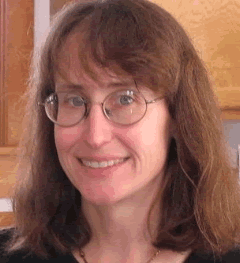|
Dr. Erica Ellingson got a BSc in Physics at MIT in 1984, and followed it with her PhD in Astronomy from the University of Arizona in 1989. She did postdoctoral fellowships at the Dominion Astrophysical Observatory, Victoria, BC and at the University of Colorado. She is now Professor of Astrophysics and Planetary Sciences at the University of Colorado, Boulder. Among many teaching and research achievements, she has written, produced and presented several planetarium shows at CU's Fiske Planetarium covering forefront research on topics such as dark matter, dark energy and galaxy evolution, and regularly presents public lectures on these topics for groups in Colorado and elsewhere. "I work mostly on topics concerning the evolution of galaxies and quasars, and observational cosmology-- the origin, contents and evolution of the universe. Much of my recent work concerns clusters of galaxies-- giant structures of hundreds or thousands of galaxies and clouds of hot gas, held together by the gravity of invisible dark matter. Some of the questions I work on include: how much dark matter is in clusters, how do clusters grow and evolve over time within the expanding universe, and how does the environment of the galaxy cluster affect the unfortunate galaxies which fall into it. I am also part of a consortium to discovery new very distant clusters (the RCS Survey, see below), with the aim of exploring how dark matter and dark energy together form and shape these giant structures over billions of years. "I love looking at the universe, and use a variety of different types of telescope for research: large and small ground-based telescopes from around the world, the Hubble Space Telescope, the Spitzer Infrared Telescope, and the Chandra and XMM-Newton X-Ray space telescopes." |
 |
About the topic
Dark Matter, Dark Energy, and Galaxy Clusters: Astronomers and physicists have been studying the Universe for hundreds of years, using ever more sophisticated instruments and techniques, only to find that everything we know anything about comprises only about 4% of the known Universe. The other 96% is made up of mysterious and poorly-understood stuff nicknamed "dark matter" and "dark energy." How did we find ourselves in this embarassing predicament? Dr. Ellingson will attempt to explain how she has been using the world's biggest telescopes to look at stuff which is really completely invisible, and what its existence means for both the origin and the fate of the Universe.
Galaxy clusters are the largest gravitationally bound objects in the universe-- the great whales of the starry deep. Although they contain hundreds of galaxies, and tremendous amounts of gas, their gigantic masses are dominated by mysterious stuff called dark matter. As the densest intersections in the cosmic web, they can help map the patterns of cosmic structure, and provide important clues about dark matter and the even-more-elusive dark energy. Dr. Ellingson will describe her search through uncharted space to find these cosmic Moby Dicks, and describe how one sees something that is completely invisible, how it can be weighed, and what this tells us about the origin and fate of the Universe.
You can read an excellent, non-technical, introduction to some of the terminology and concepts here.
NASA's Beyond Einstein: Joint Dark Energy Mission pages are quite informative about proposed future research missions.
Wikipedia is also good on dark energy.

Astronomers Find Ring of Dark Matter: The Hubble Space Telescope was used to study a pair of galaxy clusters that are colliding 5 billion light years from Earth. (To be accurate, they collided 5 billion years ago!) From the visible mass of stars and gas, the clusters should be flying apart, but they aren't. Why not--is there some mass there that can't be seen? The images of even more distant galaxies, seen through the colliding clusters, are distorted; the light from them is bent by mass it passes as it heads towards us. So the scientists mapped the degree of distortion, plotted it as a color gradient over the Hubble image of the galactic clusters, and saw a dark ring of otherwise invisible mass. This ring is almost surely dark matter, and it's an incredible 2.5 million light years across. Pictures here. Or watch the video below (4:55) from Hubblecast.
The Red Sequence Cluster (RSC) Survey: If a source of light is moving away from an observer, then redshift (z greater than 0) occurs; if the source moves towards the observer, then blue shift (z less than 0) occurs. This is true for all electromagnetic waves and is explained by the Doppler effect. Consequently, this type of redshift is called the Doppler redshift. In the classical Doppler effect, the frequency of the source is not modified, but the recessional motion causes the illusion of a lower frequency. The metric z is roughly the fraction of the speed of light at which the distant object is moving away from the observer. The RCS uses two 4-meter telescopes to observe very distant galaxy clusters; more about it here.
